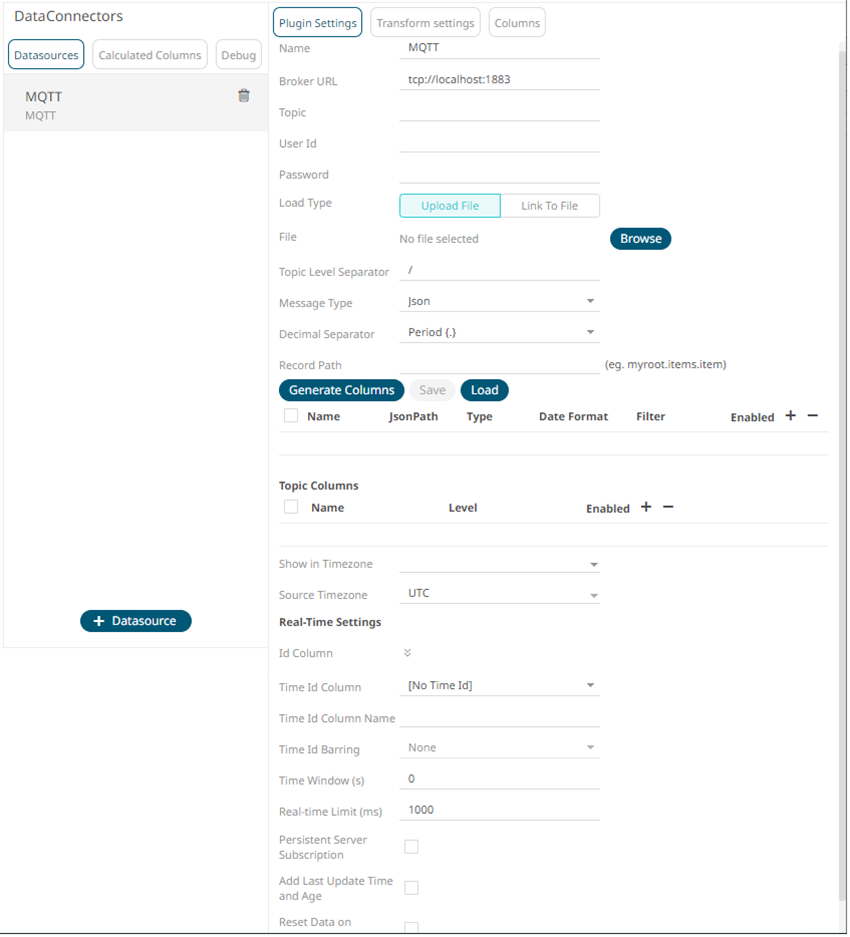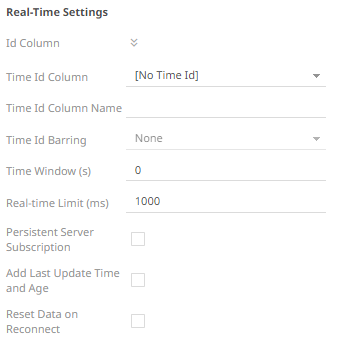MQTT
The MQTT connector allows:
q connection to MQTT’s message bus on a real-time streaming basis.
q Panopticon to subscribe to FIX, JSON, Text or XML based messages that are published on particular topics. The data format itself is arbitrary, and consequently, the connection includes the message definition.
q encrypted/SSL connections using a generated CA certificate file.
Steps:
1. Select MQTT from the Data Sources pane. The MQTT Settings pane and the retrieved MQTT source are displayed.

2. Enter the Name of the MQTT data source, then click
 .
.
3. Enter the following properties:
|
Property |
Description |
|
Broker URL |
The location of the message broker. Default is tcp://localhost:1883 |
|
Topic |
The topic or the queue physical name. Example: level1/level2/level3/level4 etc. NOTES: You can also opt to use a wild card in the topic name specification. · The plus sign symbol (+) can be used as a wild card for any value at one specific level. Example: level1/level2/+/level4 · The hash sign symbol (#) can be used as a wild card for any values across more than one level. Example: level1/#/level4 |
|
User Id |
The user Id that will be used to connect to MQTT. |
|
Password |
The password that will be used to connect to MQTT. |
4. To allow encrypted connections, you can either:
· Upload
a CA Certificate file by clicking Upload
File  then
Browse
then
Browse  to browse to the file
source.
to browse to the file
source.
After selecting the file, it is displayed with the timestamp.

To
change the certificate, click ![]() then Browse
then Browse  to browse to a new
version of the file.
to browse to a new
version of the file.
· Link
to a CA Certificate file by clicking Link
to File  and entering the File Path.
and entering the File Path.

5. In MQTT, a topic consists of one or more topic levels. Enter the Topic Level Separator to use. Default is / (forward slash).
6. Select the Message Type. This will specify the format of the data within the message:
7. Select either the dot (.) or comma (,) as the Decimal Separator.
|
NOTE |
Prepend 'default:' for the elements falling under default namespace.
|
8. Click  to the fetch the schema based on the connection
details. Consequently, the list of columns with the data type found
from inspecting the first ‘n’ rows of the input data source is populated
and the Save button is enabled.
to the fetch the schema based on the connection
details. Consequently, the list of columns with the data type found
from inspecting the first ‘n’ rows of the input data source is populated
and the Save button is enabled.
This also populates the Id Column with the set of columns, of arbitrary type, that can be concatenated to form a unique row identifier.
9. You can also opt to load or save a copy of the column definition.
10. Click  to add columns to the MQTT connection
that represent sections of the message. Then enter or select:
to add columns to the MQTT connection
that represent sections of the message. Then enter or select:
|
Property |
Description |
|
Name |
The column name of the source schema. |
|
XPath/JsonPath/Fix Tag/Column Index |
The XPath/JsonPath/Fix Tag/Column Index of the source schema. |
|
Type |
The data type of the column. Can be a Text, Numeric, or Time |
|
Date Format |
The format when the data type is Time. NOTE: To parse and format times with higher than millisecond precision, the format string needs to end with a period followed by sequence of upper case S. There can be no additional characters following them. For example: yyyy-MM-dd HH:mm:ss.SSSSSS |
|
Filter |
Defined parameters that can be used as filter. Only available for JSON, Text, and XML message types. |
|
Enabled |
Determines whether the message field should be processed. |
To delete a column,
check its  or
all the column entries, check the topmost
or
all the column entries, check the topmost  , then click .
, then click .
11. Text for topic levels can be consumed as additional columns into the data table.
The Topic Columns section shows and allows defining data table columns and mapping them to topic hierarchy levels (index based from left, 0 based).
Like columns from message
data, manually add them by clicking ![]() . A new entry
displays.
. A new entry
displays.

Name can be any unique topic level within the topic name. The Level is the hierarchy level of the topic column.
Check the Enabled box to enable a topic column.
To delete a topic column,
check its  or
all the topic column entries, check the topmost
or
all the topic column entries, check the topmost  , then click
, then click  .
.
12. Date/Time values of output data and Date/Time inputs, where supported, is by default unchanged.
You can opt to define the Show in Timezone and Source Timezone settings.
13. For this section:

Refer to Define Real-Time Settings for more information.
14. Set the row limit of the data set.
15. Tap the Preview Selected Data Source slider to turn it on.
16. Click  to display the data preview.
to display the data preview.


